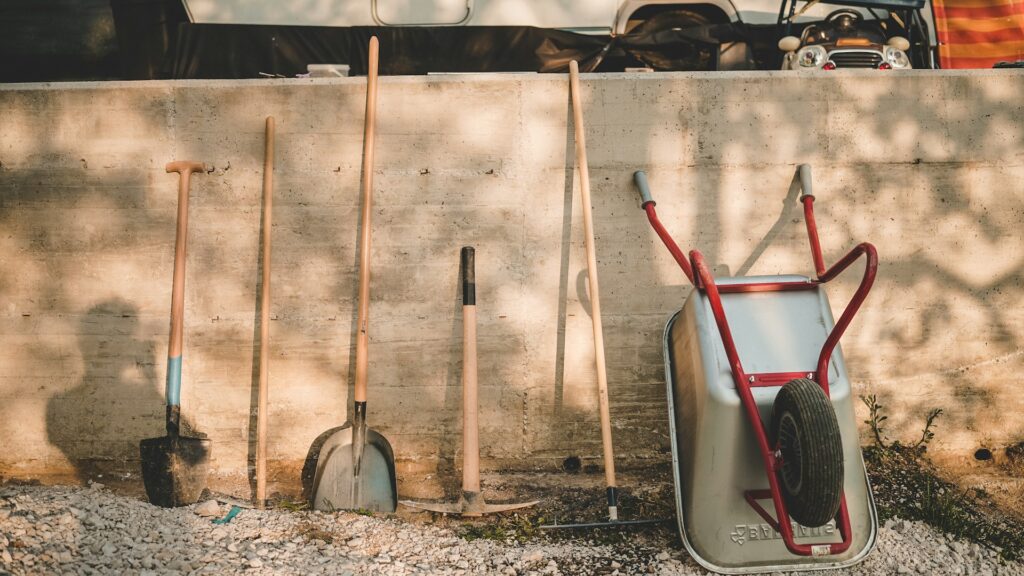
10 Must-Have Roofing Tools for Every Homeowner — Top Roofing Contractor in Beverly, MA
Maintaining a sturdy and leak-free roof is a fundamental responsibility for homeowners. Your roof shields your home from the elements and ensures the safety and comfort of your family. Drawing inspiration from a top roofing contractor in Beverly, MA, we’ve compiled a comprehensive list of the 10 must-have roofing tools every homeowner should consider. Whether you’re a seasoned DIY enthusiast or new to home maintenance, having the right tools at your disposal can make all the difference in ensuring your roof’s longevity and integrity.

1. Ladder
When it comes to maintaining your roof, safety should always be the top priority. That’s why having a reliable ladder is essential for any homeowner looking to take care of their roof. Our expert roofing contractor in Beverly, MA, understands the significance of a stable ladder for safe access to the roof, and they’re here to share some valuable insights.
Choosing the Right Ladder
Before you even think about climbing up to inspect or work on your roof, you need to make sure you have the right ladder for the job. Look for a ladder that’s sturdy and well-built, ensuring it can support your weight and provide a stable platform. Opt for ladders with anti-slip features on the steps and feet to prevent accidents, especially when working on potentially slippery surfaces like roofs.
Determining the Right Height
Ladders come in various heights, so it’s crucial to choose one that matches the height of your roof. You don’t want to end up with a ladder that’s too short, forcing you to stretch and compromise your safety. On the other hand, a ladder that’s too long can be cumbersome and difficult to maneuver. Our roofing contractor in Beverly, MA advises measuring the distance from the ground to your roof and selecting a ladder that’s a suitable match.
Safety Tips for Ladder Usage
Even with the right ladder, safety remains paramount. Here are a few tips to keep in mind when using a ladder for roof maintenance:
Stable Placement
Always place the ladder on a flat and stable surface. Avoid using objects like bricks or rocks to level the ladder, as this can compromise its stability.
Angle Matters
The angle of the ladder against the roof matters. The base of the ladder should be approximately one-quarter of the ladder’s working length away from the wall or roof edge.
Three-Point Contact
Maintain three points of contact when climbing the ladder—two feet and one hand or two hands and one foot. This ensures a secure grip while ascending or descending.
No Overreaching:
Avoid leaning too far to the side when on the ladder. If you can’t reach a certain spot comfortably, climb down and reposition the ladder instead of stretching.
Stay Centered
Keep your body centered between the rails of the ladder to maintain balance. Avoid leaning too far to either side.

2. Roofing Hammer
When it comes to roof maintenance, precision and proper installation are key. That’s where a reliable roofing hammer comes into play. Our expert roofing contractor in Beverly, MA, understands the significance of using the right tools for the job, and they’re here to shed some light on why a roofing hammer is a must-have in your toolkit.
Features That Matter
A roofing hammer isn’t just your everyday household tool. It’s specifically designed for roofing tasks, with features that make shingle installation and nail placement more efficient. The claw of the roofing hammer is perfect for removing nails, while the flat head is ideal for securing shingles in place without causing damage.
The Right Grip Matters
When using a roofing hammer, it’s essential to have the right grip to ensure precise and accurate nailing. Hold the hammer with a firm yet comfortable grip to have better control over the force applied. Our roofing contractor in Beverly, MA recommends practicing your technique on scrap materials before tackling your roof to get a feel for the tool.
Maintaining Your Roofing Hammer
Like any tool, a roofing hammer requires proper care and maintenance to perform at its best. Keep the hammer clean and free from debris that might affect its function. Check the head regularly to ensure it’s secure and doesn’t wobble, as this can impact the accuracy of your nail placement.
Safety First
When using a roofing hammer, safety is paramount. Wear appropriate protective gear, including gloves and safety goggles, to shield yourself from potential hazards. Our roofing contractor in Beverly, MA, advises working in good lighting conditions to ensure accurate nail placement and prevent mishaps.
Tips for Effective Usage
Choose the Right Nails
Use roofing nails that are appropriate for your shingles and roofing material. Different nails are designed for different materials, so consult your roofing material’s manufacturer guidelines.
Consistent Pressure
Apply consistent pressure when driving in the nails. Hammer in a controlled manner to avoid damaging the roofing materials.
Nail Placement
Nail placement is crucial for proper shingle attachment. Follow the manufacturer’s guidelines for nail spacing and positioning to ensure uniformity and prevent leaks.
Mind the Overhang
Pay attention to the overhang of the shingles. Hammering too close to the edge can cause the shingles to crack or break, compromising their effectiveness.
3. Utility Knife
When it comes to DIY roof maintenance, precision is key. That’s where a trusty utility knife comes into play. Our expert roofing contractor in Beverly, MA, knows the importance of having the right tools for the job, and they’re here to explain why a utility knife is a must-have in your roofing toolkit.
Versatility at Its Best
A utility knife isn’t just limited to roof maintenance—it’s a versatile tool that can handle a range of cutting tasks. From trimming shingles to cutting roofing felt and other materials, a utility knife can make your repair jobs neater and more efficient.
Safety First
Using a utility knife requires caution and care. Always retract the blade when not in use and ensure the blade is sharp for clean cuts. Dull blades can slip, leading to accidents. Our roofing contractor in Beverly, MA, suggests using a knife with a retractable blade for added safety.
Choosing the Right Blade
Utility knives come with various blade options, and selecting the right blade for your roofing project is crucial. For roofing tasks, opt for a hook or roofing blade. These blades have a serrated edge that makes cutting through shingles and roofing materials smoother and more precise.
Cutting Techniques
When using a utility knife for roofing repairs, follow these techniques recommended by our roofing contractor in Beverly, MA:
Score and Snap
For shingles or materials that need to be trimmed, score along the cut line and then carefully snap the material along the scored line for a clean edge.
Straight Cuts
When making straight cuts, use a straight edge as a guide to ensure your cuts are even and accurate.
Angle Cuts
For angled cuts, mark the angle using a straight edge and cut slowly and steadily along the marked line.
Maintaining Your Utility Knife
To ensure your utility knife remains effective, keep the blade sharp and clean. Regularly replace dull blades to prevent slipping and ensure clean cuts. Store your utility knife in a safe place to prevent accidents and protect the blade from damage.
4. Roofing Nailer
When it comes to roof maintenance, efficiency is the name of the game. That’s where a reliable roofing nailer comes into play. Our expert roofing contractor in Beverly, MA, knows that the right tools can make all the difference, and they’re here to share why a roofing nailer should be a staple in your toolkit.
Types of Roofing Nailers
Roofing nailers come in two main types: pneumatic and manual. Pneumatic nailers use compressed air to drive nails, making them a popular choice for professionals and homeowners alike due to their speed and ease of use. On the other hand, manual nailers require physical force to drive nails and can be more affordable for DIY enthusiasts.
Efficiency and Time Savings
A roofing nailer is all about getting the job done efficiently. With precise nail placement and quick firing mechanisms, a roofing nailer can significantly reduce the time and effort needed for shingle installation. Our roofing contractor in Beverly, MA, highlights that a roofing nailer is especially handy for larger roofing projects, where speed and accuracy are essential.
Safety Precautions
While roofing nailers can streamline the installation process, they require careful handling. Always wear safety goggles to protect your eyes from flying debris. Additionally, keep your fingers away from the nailer’s firing area to avoid accidents. Our roofing contractor in Beverly, MA, recommends familiarizing yourself with the nailer’s operation manual before use.
Choosing the Right Nails
Just like with any tool, using the right accessories is crucial. Choose roofing nails that are compatible with your roofing material and the nailer you’re using. Different materials may require different nail types, lengths, and gauges. Following manufacturer guidelines ensures a secure and lasting installation.
Maintaining Your Roofing Nailer
Regular maintenance is key to prolonging the life of your roofing nailer. Keep the nailer clean and free from debris that could affect its performance. Lubricate the moving parts as recommended by the manufacturer to ensure smooth operation. Our roofing contractor in Beverly, MA, suggests conducting routine checks to ensure all components are in working order before starting a project.
5. Roofing Shovel
When it comes to roof maintenance, precision goes hand in hand with careful material removal. This is where a reliable roofing shovel comes into play. Our expert roofing contractor in Beverly, MA, understands the importance of efficient material removal, and they’re here to share why a roofing shovel is a must-have in your toolkit.
Purposeful Material Removal
A roofing shovel, also known as a shingle remover, is designed with a specific purpose: to efficiently remove damaged or old roofing materials without causing unnecessary harm to the underlying structure. This tool features a unique edge that allows for precise and targeted removal, minimizing the risk of collateral damage.
Tips for Safe Usage
Using a roofing shovel requires a certain level of skill and care. Our roofing contractor in Beverly, MA, suggests the following tips for safe and effective usage:
Positioning
Position the shovel’s edge under the material you want to remove and apply gentle pressure to lift and separate it from the surface.
Controlled Movements
Use controlled and deliberate movements to avoid accidentally damaging surrounding materials.
Work in Sections
Divide your roof into manageable sections and work on one section at a time. This approach helps maintain control and prevent overwhelming the process.
Mind the Underlayment
Be mindful of the underlayment beneath the roofing material. The goal is to remove the top layer while leaving the underlayment intact.
Safety Precautions
Wearing appropriate safety gear is essential when using a roofing shovel. Protective gloves will safeguard your hands from sharp debris, and safety goggles will shield your eyes from any flying particles. Additionally, consider working with a partner who can assist in managing the removed materials safely.
Maintaining Your Roofing Shovel
To ensure the longevity of your roofing shovel, clean it after each use and remove any debris that might affect its performance. Inspect the blade regularly for signs of wear and replace it if necessary. Proper maintenance not only extends the tool’s lifespan but also ensures optimal functionality.

6. Caulking Gun
Sealing gaps and preventing leaks are essential aspects of roof maintenance. Enter the caulking gun, a tool that offers expert precision in sealing gaps effectively. Our seasoned roofing contractor in Beverly, MA, recognizes the significance of seamless sealing and is ready to explain why a caulking gun is a must-have tool for your roofing arsenal.
The Art of Sealing
A caulking gun might seem simple, but its ability to apply sealants with accuracy is invaluable. Whether you’re sealing gaps around flashing, vents, or chimneys, a caulking gun allows you to target specific areas and create a watertight barrier that safeguards your roof from potential leaks.
Choosing the Right Caulk
The effectiveness of a caulking gun depends on the type of caulk you use. Consult with your local hardware store or follow the recommendations of our roofing contractor in Beverly, MA, to select the appropriate caulk for your specific roofing materials. Keep in mind that different types of caulk are designed for various purposes, such as weatherproofing, waterproofing, or fire resistance.
Application Techniques
Using a caulking gun might require some practice to achieve smooth and even application. Our roofing contractor in Beverly, MA, suggests these techniques for effective caulking:
Clean the Surface
Ensure the area you’re caulking is clean and free from debris to promote proper adhesion.
Cut the Nozzle
Cut the nozzle of the caulk tube at an angle to control the size of the bead. The size of the gap you’re sealing will dictate the nozzle opening size.
Steady Pressure
Apply steady pressure on the trigger of the caulking gun to create a consistent bead of caulk along the gap.
Smooth with a Tool
After applying the caulk, use a caulk smoothing tool or your finger to smooth out the bead for a neat finish.
Safety and Cleanup
Safety is paramount when using a caulking gun. Wear gloves to protect your hands from the caulk, and work in a well-ventilated area to prevent inhaling fumes. After you’re done caulking, clean the gun and nozzle thoroughly to prevent clogs and ensure the tool’s longevity.
7. Roofing Safety Harness
Safety should never take a backseat when it comes to roof maintenance. That’s where a reliable roofing safety harness comes into play. Our experienced roofing contractor in Beverly, MA, understands the paramount importance of safety, and they’re here to elaborate on why a roofing safety harness is an essential addition to your toolkit.
Putting Safety First
Working on a roof involves heights and potential risks. A roofing safety harness is designed to provide an added layer of protection, ensuring that you can carry out repairs and inspections with confidence and minimal risk of falls or accidents.
Proper Fitting and Usage
A roofing safety harness is only effective when properly fitted and used. Our roofing contractor in Beverly, MA, offers insights into the correct way to wear and use a safety harness:
Secure Fit
Ensure the harness is snug but not too tight. Straps should be adjusted to prevent excess movement without restricting blood flow.
Attachment Points
Connect the harness to appropriate anchor points using high-quality ropes or lanyards. Follow manufacturer guidelines for proper attachment.
Regular Inspection
Regularly inspect the harness for signs of wear, tear, or damage. Replace any components that show signs of compromise.
Stay Connected
Always stay connected to your anchor point while on the roof. This prevents falls and ensures your safety while working at heights.
Types of Roofing Safety Harnesses
There are various types of safety harnesses available, catering to different preferences and needs. From full-body harnesses to safety kits that include lanyards and anchors, our roofing contractor in Beverly, MA, recommends selecting the type that best suits your project and comfort level.
Additional Safety Gear
While a roofing safety harness is a crucial tool, it’s not the only safety gear you should consider. Our roofing contractor in Beverly, MA, suggests complementing your safety harness with other essentials such as non-slip shoes, a hard hat, and safety goggles to ensure comprehensive protection while working on your roof.
8. Chalk Line
When it comes to roof maintenance, precision is the key to success. That’s where a simple yet powerful tool like a chalk line comes into play. Our trusted roofing contractor in Beverly, MA, recognizes the importance of accurate installations, and they’re ready to explain why a chalk line is a must-have tool in your roofing toolkit.
Creating Straight Guidelines
A chalk line might seem basic, but its ability to create straight and accurate guidelines is essential for maintaining a visually appealing and well-aligned roof. Whether you’re installing shingles or ensuring proper placement for other roofing materials, a chalk line helps you set the stage for precision.
Choosing the Right Chalk
Not all chalk is created equal. The type of chalk you choose can affect the visibility and longevity of your guidelines. Our roofing contractor in Beverly, MA, recommends using high-quality chalk that provides clear and long-lasting lines. Opt for chalk that’s appropriate for outdoor use and offers good contrast against your roofing material.
Proper Chalk Line Usage
Using a chalk line effectively requires attention to detail. Here’s how our roofing contractor in Beverly, MA, suggests you make the most of this simple tool:
Tight Line
Ensure the string of the chalk line is taut before snapping. This prevents the line from sagging and creating inaccurate guidelines.
Even Distribution
Apply chalk to the line evenly to achieve a clear and consistent guideline.
Steady Snap
When snapping the line, do so with a steady and swift motion to create a straight and accurate guideline.
Double-Check Measurements
Before snapping a line, double-check your measurements to ensure that your guideline will be in the right position.
Versatility Beyond Roofing
While a chalk line is an excellent tool for roofing projects, it’s also versatile enough to be used for other tasks around the house. From marking lines for painting to setting up guidelines for tiling, a chalk line’s utility extends beyond the realm of roof
9. Pry Bar
When it comes to roof maintenance, sometimes you need to take things apart before you can put them back together. This is where a versatile tool like a pry bar comes into play. Our knowledgeable roofing contractor in Beverly, MA, recognizes the importance of efficient material removal and is ready to explain why a pry bar is an indispensable tool for your roofing toolkit.
Versatility in Material Removal
A pry bar, also known as a crowbar, is designed for gentle yet effective material removal. Whether you’re removing old shingles, nails, or other roofing components, a pry bar allows you to carefully dismantle materials without causing unnecessary damage to the underlying structure.
Mastering Pry Bar Techniques
Using a pry bar effectively requires finesse and control. Our roofing contractor in Beverly, MA, offers these techniques for successful pry bar usage:
Positioning
Place the flat end of the pry bar under the material you want to remove and apply gentle upward pressure.
Leverage
Use the length of the pry bar to your advantage. The longer the bar, the more leverage you can apply, making material removal easier.
Controlled Force
Apply controlled and gradual force to prevent sudden movements that could lead to damage or accidents.
Mindful Removal
Be mindful of the surrounding materials as you remove components. The goal is to maintain the integrity of the roof while taking materials apart.
Choosing the Right Pry Bar
Pry bars come in various sizes and shapes, each suited for different tasks. Our roofing contractor in Beverly, MA, suggests selecting a pry bar with a flat and wide edge for roofing projects. Opt for a pry bar made from high-quality steel to ensure durability and longevity.
Safety and Material Protection
Safety should always be a priority when using a pry bar. Wear gloves to protect your hands from sharp edges and flying debris. Additionally, consider using a piece of scrap material to protect the roof’s surface from the pry bar’s edge, minimizing the risk of unintentional damage.

10. Measuring Tape
In the world of roof maintenance, accuracy is everything. That’s where a simple yet essential tool like a measuring tape comes into play. Our seasoned roofing contractor in Beverly, MA, recognizes the significance of precise measurements and is here to explain why a measuring tape is a must-have tool in your roofing toolkit.
Accurate Measurements for Successful Installations
From aligning shingles to ensuring proper spacing, accurate measurements are essential for flawless roof installations. A measuring tape allows you to take precise measurements that contribute to the overall durability and visual appeal of your roof.
Choosing the Right Measuring Tape
Not all measuring tapes are created equal. Consider the type of projects you’ll be tackling and the environment in which you’ll be working. Our roofing contractor in Beverly, MA, suggests opting for a measuring tape that is sturdy, easy to read, and has a locking mechanism to secure the tape in place while you take measurements.
Measurement Techniques
Taking accurate measurements requires attention to detail and proper technique. Our roofing contractor in Beverly, MA, offers these tips for successful measuring tape usage:
Start from Zero
When measuring, ensure the beginning of the tape is aligned with the starting point. This prevents inaccuracies due to the tape’s casing.
Avoid Slippage
Use the locking mechanism to hold the tape in place when taking measurements. This prevents the tape from retracting and skewing the measurement.
Consistent Units
Stick to a consistent unit of measurement, whether it’s inches, feet, or meters, to prevent confusion and errors.
Double-Check
After taking a measurement, double-check to ensure accuracy. It’s better to spend a few extra moments verifying measurements than to proceed with incorrect dimensions.
Versatility Beyond Roofing
While a measuring tape is a must-have for roof maintenance, its utility extends to various other projects around the house. From measuring furniture to planning home renovations, a measuring tape is a versatile tool that should be part of every homeowner’s toolkit.
Upgrade Your Roofing Toolkit Today for Safer, Smoother DIY Repairs!
Ready to equip yourself with the essential tools for successful roof maintenance? At Roofer of Beverly, MA, we’re more than just a roofing contractor – we’re your partners in keeping your roof in top shape. Our experienced team understands the value of having the right tools for the job, and we’re here to provide expert advice and services to ensure your roof remains sturdy and leak-free. Whether you’re a homeowner looking to enhance your DIY efforts or in need of professional assistance, we’ve got you covered. Reach out to us today to discuss your roofing needs, get recommendations on the best tools, and learn how we can work together to maintain the integrity of your roof for years to come.
